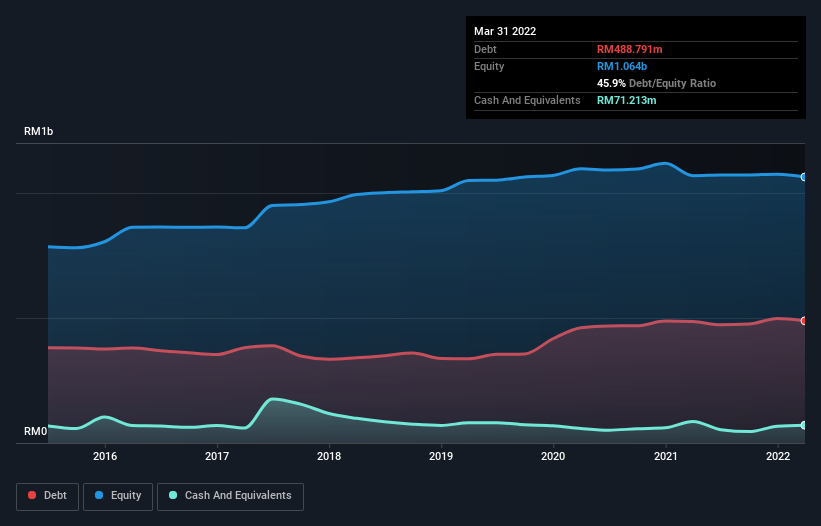- Malaysia
- /
- Real Estate
- /
- KLSE:ASIAPAC
Here's Why Asian Pac Holdings Berhad (KLSE:ASIAPAC) Has A Meaningful Debt Burden

David Iben put it well when he said, 'Volatility is not a risk we care about. What we care about is avoiding the permanent loss of capital.' So it might be obvious that you need to consider debt, when you think about how risky any given stock is, because too much debt can sink a company. Importantly, Asian Pac Holdings Berhad (KLSE:ASIAPAC) does carry debt. But the more important question is: how much risk is that debt creating?
Why Does Debt Bring Risk?
Debt assists a business until the business has trouble paying it off, either with new capital or with free cash flow. In the worst case scenario, a company can go bankrupt if it cannot pay its creditors. While that is not too common, we often do see indebted companies permanently diluting shareholders because lenders force them to raise capital at a distressed price. By replacing dilution, though, debt can be an extremely good tool for businesses that need capital to invest in growth at high rates of return. When we examine debt levels, we first consider both cash and debt levels, together.
Check out our latest analysis for Asian Pac Holdings Berhad
How Much Debt Does Asian Pac Holdings Berhad Carry?
The chart below, which you can click on for greater detail, shows that Asian Pac Holdings Berhad had RM488.8m in debt in March 2022; about the same as the year before. However, it also had RM71.2m in cash, and so its net debt is RM417.6m.

How Healthy Is Asian Pac Holdings Berhad's Balance Sheet?
According to the last reported balance sheet, Asian Pac Holdings Berhad had liabilities of RM261.5m due within 12 months, and liabilities of RM697.0m due beyond 12 months. On the other hand, it had cash of RM71.2m and RM61.4m worth of receivables due within a year. So its liabilities total RM825.8m more than the combination of its cash and short-term receivables.
This deficit casts a shadow over the RM126.6m company, like a colossus towering over mere mortals. So we'd watch its balance sheet closely, without a doubt. At the end of the day, Asian Pac Holdings Berhad would probably need a major re-capitalization if its creditors were to demand repayment.
In order to size up a company's debt relative to its earnings, we calculate its net debt divided by its earnings before interest, tax, depreciation, and amortization (EBITDA) and its earnings before interest and tax (EBIT) divided by its interest expense (its interest cover). This way, we consider both the absolute quantum of the debt, as well as the interest rates paid on it.
Asian Pac Holdings Berhad shareholders face the double whammy of a high net debt to EBITDA ratio (16.1), and fairly weak interest coverage, since EBIT is just 0.85 times the interest expense. The debt burden here is substantial. One redeeming factor for Asian Pac Holdings Berhad is that it turned last year's EBIT loss into a gain of RM23m, over the last twelve months. The balance sheet is clearly the area to focus on when you are analysing debt. But it is Asian Pac Holdings Berhad's earnings that will influence how the balance sheet holds up in the future. So when considering debt, it's definitely worth looking at the earnings trend. Click here for an interactive snapshot.
Finally, while the tax-man may adore accounting profits, lenders only accept cold hard cash. So it's worth checking how much of the earnings before interest and tax (EBIT) is backed by free cash flow. Over the last year, Asian Pac Holdings Berhad actually produced more free cash flow than EBIT. There's nothing better than incoming cash when it comes to staying in your lenders' good graces.
Our View
On the face of it, Asian Pac Holdings Berhad's interest cover left us tentative about the stock, and its level of total liabilities was no more enticing than the one empty restaurant on the busiest night of the year. But on the bright side, its conversion of EBIT to free cash flow is a good sign, and makes us more optimistic. We're quite clear that we consider Asian Pac Holdings Berhad to be really rather risky, as a result of its balance sheet health. For this reason we're pretty cautious about the stock, and we think shareholders should keep a close eye on its liquidity. When analysing debt levels, the balance sheet is the obvious place to start. But ultimately, every company can contain risks that exist outside of the balance sheet. For example Asian Pac Holdings Berhad has 4 warning signs (and 1 which can't be ignored) we think you should know about.
When all is said and done, sometimes its easier to focus on companies that don't even need debt. Readers can access a list of growth stocks with zero net debt 100% free, right now.
New: Manage All Your Stock Portfolios in One Place
We've created the ultimate portfolio companion for stock investors, and it's free.
• Connect an unlimited number of Portfolios and see your total in one currency
• Be alerted to new Warning Signs or Risks via email or mobile
• Track the Fair Value of your stocks
Have feedback on this article? Concerned about the content? Get in touch with us directly. Alternatively, email editorial-team (at) simplywallst.com.
This article by Simply Wall St is general in nature. We provide commentary based on historical data and analyst forecasts only using an unbiased methodology and our articles are not intended to be financial advice. It does not constitute a recommendation to buy or sell any stock, and does not take account of your objectives, or your financial situation. We aim to bring you long-term focused analysis driven by fundamental data. Note that our analysis may not factor in the latest price-sensitive company announcements or qualitative material. Simply Wall St has no position in any stocks mentioned.
About KLSE:ASIAPAC
Asian Pac Holdings Berhad
An investment holding company, engages in the property development and investment businesses in Malaysia.
Good value slight.
Similar Companies
Market Insights
Community Narratives




